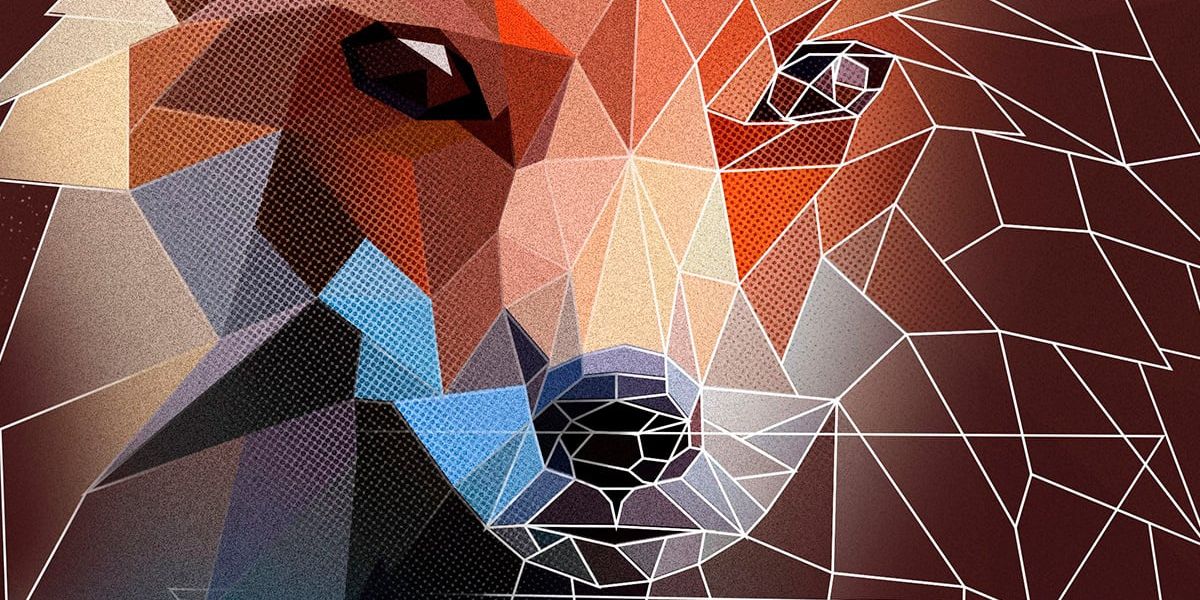Low poly art is one of the most exciting design trends right now. A low poly portrait is a fun new technique to design. Do you know what the term ‘low poly art’ means?
Consider the word polygon if you’re not sure what it implies. Low poly art is merely a method of producing a polygon mesh in order to build a famous face or portrait.
Low poly design may be breathtaking! It’s difficult to believe you’re looking at a collection of polygons rather than a highly detailed portrait. The end effect is quite imaginative.
What is Low Poly Art?
You may not have heard of low poly design, but you have most likely seen work in this manner. Low poly pictures are made by stacking geometric forms. The term ‘poly’ refers to a 2D geometric shape called a polygon. The end product is frequently austere, dramatic, and quite effective.
Low poly animation began in the early days of 3D animation. Because it lowered rendering times, creating low poly artwork aided in the speeding up of the animation process. This technique is still used today. Low poly graphics, on the other hand, are becoming more popular as a design trend in their own right.
As minimalism grows in popularity, designers, illustrators, and video game developers are adopting low poly graphics to show detail while adhering to a minimalist design aesthetic.
The History of Low Poly Images
Low polygonal art can be traced back to the early days of 3D animation. Low poly art saved time when rendering.
Creating a mesh of shapes with minimal detail saved a significant amount of time. The images were not particularly detailed or intricate. The low poly art style evolved as a convenience, but it is today valued in its own right.
The Details of Low Poly Design
Depending on the amount of shapes used to produce a picture, low poly graphics can be simple or complicated. To produce a polygon portrait, some photos may utilize hundreds of shapes. The majority of low poly art, on the other hand, is made up of hundreds of pictures. Designers can also utilize a greater number of shapes in specific regions of a design to create a gradient effect.
When designers work on a low poly art project, the goal is to create the illusion of a 3D artwork. Many designers employ as little color or shape as possible to assist the viewer in recognizing the object generated while keeping their low poly pictures as simple as possible. As a result, a page will frequently appear crumpled or folded origami-style.
How to Make Low Poly Art?
Automated software can be used to make low poly art, but the outcomes cannot be guaranteed. Instead, use Blender, 3DS Max, Maya, or any similar tool to generate low poly designs.

You can then add color, based on the most prevalent colors that show in a region. When working up close, making low poly art may appear precise and even pedantic, but when zoomed out, the results are magnificent.
The Secret to Creating Awesome Low Polygon Art
Decide on Your Source Material
You’ll need a high-quality image to work from when creating low poly graphics. Look for an image with a good structure to use as a foundation for your creations.
This will assist you in producing excellent results. It’s difficult to make low poly art from your mind, so spend some time looking for a wonderful image to use as inspiration.
Explore the Shapes You’d Like to Use
To create stunning graphics, most low poly pictures use straight-lined shapes. Although curved images can be used, they are uncommon. Low poly graphics frequently have very geometric features and are not organic.
Many designers deal with basic forms like triangles and polygons. Your shapes don’t have to be the same size, and you can utilize shapes with varying sides or proportions.
However, how you mix your forms will have a significant impact on the final image. Choosing which forms to include in your low poly image is a vital component of your design.
Will You Use Symmetry in Your Designs?
Do you want to employ symmetry when making a polygon picture? Do you want each side to reflect the other? Low poly art doesn’t have to be symmetrical.

You can practice creating abstract art by making designs that are asymmetrical and have a different purpose or direction on each side.
What Dimension Will You Be Working in?
Will you be working in 2D or 3D designs when creating your low poly art? The majority of low poly art is created in 2D. This is due to the fact that low poly art frequently produces the illusion of a 3D design. They can, however, work in 3D.
Many low poly art designs offer the sense of a three-dimensional form. The image might be incredibly detailed and stand out from the rest of the page. Some designs, on the other hand, are flatter and less 3D.
What Will Be the Context of Your Low Poly Image?
Illustrations influence many low poly designs. Although low poly started with early animation and then evolved into logos, it is now becoming a significant part of graphic design.
The mixing of different shapes produces eye-catching visuals. Low poly graphics can be used in a variety of ways, including digital and print designs.
How Would You Like to Use This Trend?
With low poly art becoming more popular, it is up to you to come up with your own innovative applications for this approach.
What images would you like to form and how would you like to utilize your designs? Choose colors, shading, and textures to help you add dimension to your drawings. You can also experiment with depths. Logos, drawings, and website designs benefit greatly from low poly art.
Frequently Asked Questions About Low Poly Art
What Are Some Popular Software Tools Used for Creating Low Poly Art?
Blender, Adobe Illustrator, Photoshop, and 3D Studio Max are popular low poly graphics software packages.
Artists can create low poly art with these tools by generating 3D models with fewer polygons and applying textures and colors.
What Are Some Key Features of Low Poly Art?
Low poly art is distinguished by the use of geometric shapes, limited color palettes, and a minimalist aesthetic. Low poly art is commonly used to create stylized, simplified renditions of landscapes, buildings, and objects.
How is Color Used in Low Poly Art?
Color is important in low poly art, as it is commonly used to provide depth and contrast to the picture.
A restricted color palette is often utilized to generate a coherent and simple design.
How Does Low Poly Art Differ From Other Digital Art Styles?
Low poly art differs from other forms of digital art in that it is minimalistic and employs streamlined geometric forms.
It is widely used to create a stylized, modern aesthetic.
What Are Some Tips for Creating Effective Low Poly Art?
Using a limited color palette, creating contrast with color and shading, and paying attention to the image’s composition are all tips for creating good low poly art.
Effective low poly art also necessitates meticulous attention to detail and familiarity with 3D modeling software.
What Are Some Common Subject Matters in Low Poly Art?
Landscapes, structures, and objects are frequently featured in low poly art. Animals, people, and abstract designs are just a handful of the various things that low poly art may offer.
How Has Low Poly Art Been Used in Commercial Design and Advertising?
Low poly art has been used in advertising and commercial design to provide a current and stylized image.
It’s been used in advertisements for anything from smartphones to vehicles.
What is the History and Evolution of Low Poly Art?
Early computer game graphics used simple geometric shapes to generate 3D models, which gave rise to low poly art.
Since then, the technology has progressed and is now employed in a variety of applications such as graphic design, animation, and virtual reality.
What is the History and Evolution of Low Poly Art?
Low poly art is predicted to alter in the future as new technologies are developed.
Low poly art is becoming more popular in virtual and augmented reality applications, and it is likely to remain popular in commercial design and advertising.
As technology progresses, low poly art is expected to become increasingly more sophisticated and popular.
Examples of Low Poly Art
We’ve compiled a selection of fantastic low poly photos to help you determine how to do low poly graphics for your creative tasks.
Using geometric shapes, low poly art has been used to produce lovely depictions of the natural world. The Diamantina waterfalls in Brazil are featured in the Everywhere Project. Beautiful animal photos commissioned by Greenpeace are also available. These creatures were featured on banners at the ‘Save the Arctic’ conference.
Conclusion
If you enjoy low poly art and want to stay current, you may start by including some low poly images intDocs your designs. We hope that this essay has inspired you and that you will love working in such an appealing and vivid medium.






